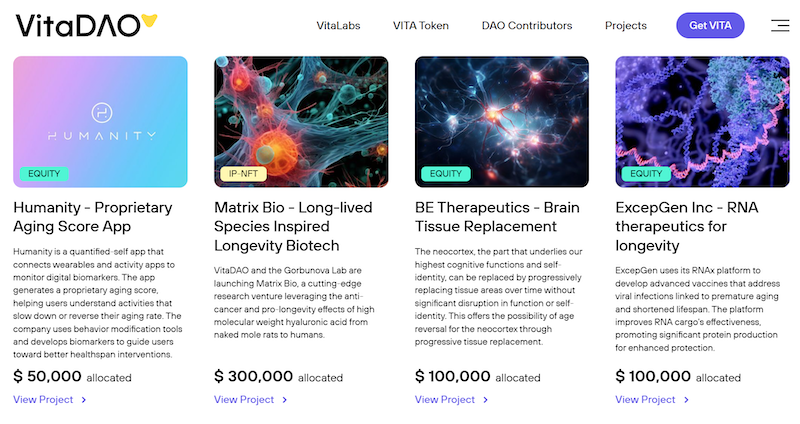Crypto Billionaires and the Quest for Immortality
It seems that once someone becomes a crypto billionaire, the next goal is often discovering the secret to avoiding mortality. This interest in extending life isn’t simply a passing fad; it’s a trend with deep roots in the community. In early 2020, as the COVID-19 pandemic brought the issue of mortality to the forefront, Ethereum co-founder Vitalik Buterin voiced his support for anti-aging research. He stated that aging is a humanitarian disaster, prompting him to put significant financial backing behind the cause.
Following Buterin’s lead, Bitcoin OG Roger Ver plans to undergo cryogenic preservation upon his passing. Tron founder Justin Sun donated $51 million to the Longevity Prize, while Cardano founder Charles Hoskinson invested $100 million in a Wyoming clinic planning stem cell and hyperbaric oxygen chamber therapy trials. Hoskinson himself has offered to be the first test subject. “If my hypothesis is right, we can reverse aging by over 10 years,” Hoskinson told DL News. These examples represent a wider pattern of crypto leaders investing in extending healthspans.

The Connection: Money, Time, and Audacity
Benji Leibowitz, founder of the longevity research platform Pump.science, suggests that it is natural for crypto millionaires to focus on problems their wealth can’t solve. Having solved the money problem, they then realize that time is the ultimate scarce resource. The crypto world is “audacious” and attracts those who believe they can “engineer their way out of anything.”
This combination of a “Wild West attitude” and abundant resources seems to fuel the interest in longevity. Crypto’s ethos of disrupting established systems, and its focus on long-term, potentially world-changing projects, aligns well with the goals of longevity research.

Former Coinbase chief technology officer Balaji Srinivasan has incorporated longevity into his Network School program. He is working with Bryan Johnson, a multi-millionaire also obsessed with slowing down aging. Johnson has indicated he would have devoted his entire life to crypto had he not been so focused on eliminating age-related deterioration.

Coinbase CEO Brian Armstrong has also entered the fray, allocating 2% of his Coinbase shares to fund longevity research. He co-founded New Limit to extend lifespan. Armstrong recognizes this research as an area where breakthroughs are possible, considering it “hard but tractable.” He also invested in the Dog Aging Project, which is testing the drug Rapamycin to slow aging in dogs.
Crypto and Longevity: A Natural Alignment?
Matt Kaeberlein, co-director of the Dog Aging Project, notes that the crypto community is increasingly investing in longevity research. He has observed a “natural sort of connection between the tech community, crypto community and the longevity community,” describing these groups as “big thinkers, people who tend to think outside the box.”
Dr. Max Unfried of the National University of Singapore’s Center for Healthy Longevity adds that crypto donations help fill the funding gap, as traditional resources are often allocated towards curing diseases rather than extending lifespan. Crypto’s willingness to fund experimental research, coupled with a libertarian mindset aligned with self-autonomy, makes it a good fit for longevity research and biohacking.

Numerous decentralized autonomous organizations (DAOs) are emerging to support longevity research. VitaDAO, for example, has funded dozens of research projects. Other DAOs focus on specific areas like biological replacement parts, cryogenics, biohacking, and using crypto to incentivize health data sharing.
The Hacker Mindset
The hacker mindset of the crypto community is another driver of interest in longevity. Alex Miloski, co-lead of the Web3 pod at VitaDAO, believes this mindset can lead crypto people to biohacking. Mgoes of BiohackerDAO sees longevity or biohacking as simply technology applied to biology. BiohackerDAO is a group seeking to self-experiment with and measure biomarkers. They raised $1.3 million on Juicebox to support various projects. Their focus is on finding ways to hack the human body for longevity.

Mgoes, who spent a week learning from Brian Johnson, notes the connection between crypto and longevity, adding, “Crypto people are very tech savvy, and longevity or biohacking is basically just technology applied to biology, to the human body.”

The BiohackerDAO has launched Intra, a tokenized platform intended to trade fitness tracker data.
Transhumanism and the Future
Some of the ideas in the longevity space are aligned with “transhumanism,” a movement seeking to use technology to transcend human limitations. SingularityNet founder Ben Goertzel is a well-known transhumanist in crypto. He believes AI will play a key role in achieving “Longevity Escape Velocity” – the point at which medical science extends lifespan by more than one year for every year lived.

Futurist José Cordeiro believes the link between crypto and longevity is straightforward. He states that those in crypto are “very futuristic minded, and so they get interested over time in all subjects about the future, and that includes longevity.” However, longevity researcher Kaeberlein cautions against overstating progress, noting that the field is far more complicated than often portrayed.
He warns that discussing a 500-year extension to the human lifespan discounts the likely achievements within the next 20 years. Despite this, he recognizes that longevity is an area where a great deal of work is being done. The intersection of cryptocurrency and the desire to extend the human lifespan is set to be an interesting space to watch in the coming years.

